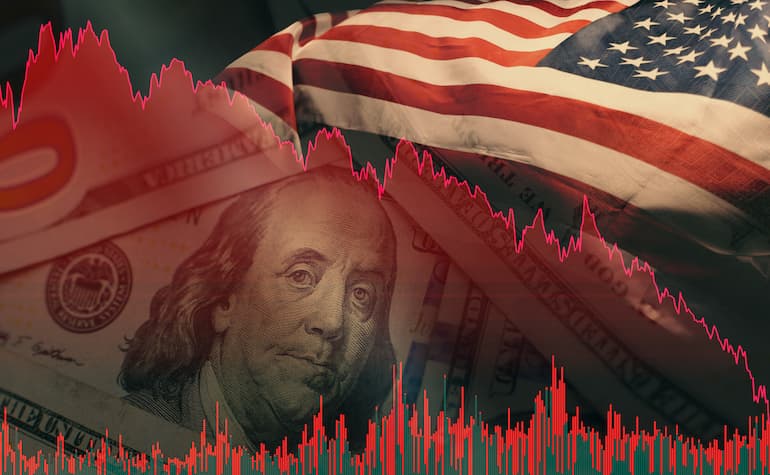Notícias de mercado & insights
Mantenha-se à frente dos mercados com insights de especialistas, notícias e análise técnica para orientar suas decisões de negociação.

Multi-Timeframe (MTF) analysis is not just about checking the trend on the daily before trading on the hourly; ideally, it involves examining and aligning context, structure, and timing so that every trade is placed with purpose.
When done correctly, MTF analysis can filter market noise, may help with timing of entry, and assist you in trading with the trending “tide,” not against it.
Why Multi-Timeframe Analysis Matters
Every setup exists within a larger market story, and that story may often define the probability of a successful trade outcome.
Single-timeframe trading leads to the trading equivalent of tunnel vision, where the series of candles in front of you dominate your thinking, even though the broader trend might be shifting.
The most common reason traders may struggle is a false confidence based on a belief they are applying MTF analysis, but in truth, it’s often an ad-hoc, glance, not a structured process.
When signals conflict, doubt creeps in, and traders hesitate, entering too late or exiting too early.
A systematic MTF process restores clarity, allowing you to execute with more conviction and consistency, potentially offering improved trading outcomes and providing some objective evidence as to how well your system is working.
Building Your Timeframe Hierarchy
Like many effective trading approaches, the foundation of a good MTF framework lies in simplicity. The more complex an approach, the less likely it is to be followed fully and the more likely it may impede a potential opportunity.
Three timeframes are usually enough to capture the full picture without cluttering up your chart’s technical picture with enough information to avoid potential contradiction in action.
Each timeframe tells a different part of the story — you want the whole book, not just a single chapter.

Scalpers might work on H1-M15-M5, while longer-term traders might prefer H4-H1-H15.
The key is consistency in approach to build a critical mass of trades that can provide evidence for evaluation.
When all three timeframes align, the probability of at least an initial move in your desired direction may increase.
An MTF breakout will attract traders whose preference for primary timeframe may be M15 AND hourly, AND 4-hourly, so increasing potential momentum in the move simply because more traders are looking at the same breakout than if it occurred on a single timeframe only.
Applying MTF Analysis
A robust system is built on clear, unambiguous statements within your trading plan.
Ideally, you should define what each timeframe contributes to your decision-making process:
- Trend confirmed
- Structure validated
- Entry trigger aligned
- Risk parameters clear
When you enter on a lower timeframe, you are gaining some conviction from the higher one. Use the lower timeframe for fine-tuning and risk control, but if the higher timeframe flips direction, your bias must flip too.
Your original trading idea can be questioned and a decision made accordingly as to whether it is a good decision to stay in the trade or, as a minimum action, trail a stop loss to lock in any gains made to date.
Putting MTF into Action
So, if the goal is to embed MTF logic into your trade decisions, some step-by-step guidance may be useful on how to make this happen
1. Define Your Timeframe Stack
Decide which three timeframes form your trading style-aligned approach.
The key here is that as a starting point, you must “plant your flag” in one set, stick to it and measure to see how well or otherwise it works.
Through doing this, you can refine based on evidence in the future.
One tip I have heard some traders suggest is that the middle timeframe should be at least two times your primary timeframe, and the slowest timeframe at least four times.
2. Build and Use a Checklist
Codify your MTF logic into a repeatable routine of questions to ask, particularly in the early stages of implementing this as you develop your new habit.
Your checklist might include:
- Is the higher-timeframe trend aligned?
- Is the structure supportive?
- Do I have a valid trigger?
- Is risk clearly defined?
This turns MTF from a concept into a practical set of steps that are clear and easy to action.
3. Consider Integrating MTF Into Open Trade Management
MTF isn’t just for entries; it can also be used as part of your exit decision-making.
If your higher timeframe begins showing early signs of reversal, that’s a prompt to exit altogether, scale out through a partial close or tighten stops.
By managing trades through the same multi-timeframe approach that you used to enter, you maintain logical consistency across the entire lifecycle of the trade.
Final Action
Start small. Choose one instrument, one timeframe set, and one strategy to apply it to.
Observe the clarity it adds to your decisions and outcomes. Once you see a positive impact, you have evidence that it may be worth rolling out across other trading strategies you use in your portfolio.
Final Thought
Multi-Timeframe Analysis is not a trading strategy on its own. It is a worthwhile consideration in ALL strategies.
It offers a wider lens through which you see the market’s true structure and potential strength of conviction.
Through aligning context, structure, and execution, you move from chasing an individual group of candles to trading with a more robust support for a decision.


Markets were predictably quite due to holidays in the US and Japan on Thursday. USD was marginally softer overall with DXY dropping to test the support at the 200-day MA before recovering modestly amid the holiday lull for Thanksgiving. Source:TradingView.com EURUSD managed mild gains with price action choppy around the 1.0900 level but eventually managed to hold that key level.
There were several hawkish leaning comments from ECB officials and ECB Minutes noting that members argued in favour of keeping the door open for a possible further rate. Source:TradingView.com GBPUSD extended on its mid-week bounce and made further progress above 1.2500 after UK manufacturing and services PMI figures beat forecasts. Source:TradingView.com USDJPY ended flat for the session but not before a sharp dip reversed following a bounce off support at 149.00 and seeing the pair again settle above 149.50.
Source:TradingView.com Ahead on Fridays, US traders will be mostly offline meaning another likely low volume session, we do have Manufacturing and Services PMI figures out of the US later today though.


The Euro was softer In Wednesdays US session with EURUSD failing to hold above the psychological 1.10 level with cooler than expected inflation readings out of Spain and Germany weighing on the single currency. EURGBP dropped for the fifth straight session and setting new November lows. Comments from ECB member Stournaras pushing back on April rate cut bets failing to offer much support.
Chart Source: TradingView.com JPY firmed against the USD, USDJPY still playing catch up with US – JP rate differentials. US yields were again lower across the curve putting downward pressure on USDJPY. The Yen did give up some gains after some dovish comments from the BoJ's Adachi regarding the BoJ’s easy money policies.
Chart Source: TradingView.com After a recent tear higher AUD was the G10 underperformer while across the ditch NZD was one of the outperformers. NZDUSD spiking higher following a hawkish hold from the RBNZ where the Central bank left rates on hold as expected, but it raised both its OCR and CPI forecasts and left the door wide open for future hikes if needed. AUDNZD tumbling through its 2023 range midpoint support at 1.07735 and setting new November lows.
Chart Source: TradingView.com Gold rallied for the fifth straight session, despite a bounce in the USD. XAUUSD poking it’s head above 20250 USD an ounce and entering the resistance zone set in April – May before paring some of its gains. The 2047-2067 zone looking a key area to test the rampant gold bull run of the last two weeks.
Chart Source: TradingView.com


Deere & Company (NYSE: DE) reported the latest results for the fourth-quarter ending October 29, 2023 and full fiscal 2023 before the market opens in the US on Wednesday. The American manufacturer of farm machinery and industrial equipment beat Wall Street estimates for the fourth-quarter but fell short on future outlook expecations. Company overview Founded: 1837 Headquarters: Moline, Illinois, United States Number of employees: 82,200 (2022) Industry: Agricultural machinery, heavy equipment Key people: John C.
May (Chairman, CEO & President) The results The company reported revenue of $15,412 billion (down by 1% year-over-year) vs. $13.641 billion expected. Earnings per share reached $8.26 (up by 11.02% year-over-year) vs. estimate of $7.462 per share. Full-year revenue reached $61,251 billion, up by 16.49% vs. 2022.
Deere expects revenue of between $7.75 to $8.25 billion for full-year 2024, below $9.31 billion expected. CEO commentary "Deere’s fourth-quarter and full-year results can be attributed to the successful execution of our Smart Industrial Operating Model and the value that customers recognize in our industry-leading products and solutions," John C. May, CEO of Deere said in a statement. "We must also recognize and credit our dedicated employees, dealers, and suppliers, whose hard work and focus have been instrumental to our overall success," May added.
Stock reaction The stock was down by around 3% on Wednesday despite beating analyst estimates for the previous quarter due to future outlook. Stock performance 1 month: -0.80% 3 months: -6.43% Year-to-date: -13.95% 1 year: -15.67% Deere & Company stock price targets Canaccord Genuity: $400 Evercore ISI Group: $424 HSBC: $486 Deutsche Bank: $407 Stifel: $460 Oppenheimer: $458 UBS: $408 Credit Suisse: $551 JP Morgan: $380 DA Davidson: $510 Citigroup: $475 BMO Capital: $425 Deere & Company is the 126th largest company in the world with a market cap of $106.07 billion. You can trade Deere & Company (NYSE: DE) and many other stocks from the NYSE, NASDAQ, HKEX, ASX, LSE and DE with GO Markets as a Share CFD.
GO Markets now offers pre-market and after-market trading on popular US Share CFDs. Trade the pre-market session: 4:00am to 9:30am, normal session, and after-market session: 4:00pm to 8:00pm, Eastern Standard Time. Why trade during extended hours?
Volatility never sleeps. Trade over earnings releases as they happen outside of main trading hours Reduce your risk and hedge your existing positions ahead of a new trading day Extended trading hours on popular US stocks means extended opportunities Sources: Deere & Company, TradingView, MarketWatch, Benzinga, CompaniesMarketCap, FactSet


The world’s largest supermarket chain Walmart Inc. (NYSE: WMT) released third quarter earnings results before the market opened in the US on Thursday. Walmart beat Wall Street estimates for both revenue and earnings per share (EPS). Company overview Founded: July 2, 1962 Headquarters: Bentonville, Arkansas, United States Number of employees: 2.1 million (2023) Industry: Retail Key people: Greg Penner (Chairman), Doug McMillon (President and CEO) The results Walmart reported revenue of $160.804 billion for the quarter (up by 5.2% year-over-year) vs. $159.651 billion expected.
EPS reported at $1.53 per share (up by 2% year-over-year) vs. estimate of $1.522 per share. Walmart raised its full-year net sales growth forecast from between 4%-4.5% to between 5%-5.5%. Adjusted EPS expected to reach between $6.40-$6.48 per share vs. analyst estimate of $6.48 per share.
CEO commentary "We had strong revenue growth across segments for the quarter, and we’re excited to get an early start to the holiday season. From a Thanksgiving meal that costs less than last year, to great prices on fashion, toys, electronics, and seasonal decorations, we’re here to help families from around the world make this a special time. Looking ahead, our inventory is in good shape, the teams are focused, and our associates are ready to serve our customers and members whenever and however they want to be served,'' CEO of Walmart, Doug McMillon said in a letter to investors.
Stock reaction" [insert chart image attached to the email] Shares of Walmart fell by around 7% on Thursday on future outlook despite beating Q3 estimates. Stock performance 1 month: -2.37% 3 months: +0.82% Year-to-date: +10.70% 1 year: +6.05% Walmart stock price targets Jefferies: $195 Stifel: $171 Stephens & Co.: $190 Tigress Financial: $196 Piper Sandler: $210 HSBC: $200 Evercore ISI Group: $177 Citigroup: $180 TD Cowen: $185 Walmart is the 16th largest company in the world with a market cap of $421.71 billion. You can trade Walmart Inc. (NYSE: WMT) and many other stocks from the NYSE, NASDAQ, HKEX, ASX, LSE and DE with GO Markets as a Share CFD.
GO Markets now offers pre-market and after-market trading on popular US Share CFDs. Trade the pre-market session: 4:00am to 9:30am, normal session, and after-market session: 4:00pm to 8:00pm, Eastern Standard Time. Why trade during extended hours?
Volatility never sleeps. Trade over earnings releases as they happen outside of main trading hours Reduce your risk and hedge your existing positions ahead of a new trading day Extended trading hours on popular US stocks means extended opportunities Sources: Walmart Inc., TradingView, MarketWatch, MetaTrader 5, Benzinga, CompaniesMarketCap, Financial Times


Recent US figures have seen a rout in treasury yields with the flagship 10-year now yielding 4.435% after starting November at 16-year highs north of 5% and in a seemingly unstoppable uptrend. A cooler CPI and PPI showing inflation is decelerating at a faster pace than the market anticipated, along with weaker employment and industrial production figures have traders re-adjusting for a less hawkish Fed and bringing their timing forward for the pricing in of rate cuts. Why this is important to serious FX traders is because rates and FX have a high correlation, even more in the post pandemic period of cuts, hikes and peak rates and maybe cuts again, big FX traders look for yield and that can be used as important information for smaller players to position themselves to take advantage of that.
An example of this relationship can be seen on the weekly chart of the US Dollar index below. The US dollar Index has fallen 2.5% so far in November, a move first started with the big miss in NFP which saw support at the 23.6 Fib level broken, then accelerating this week on a Cooler CPI which saw it take out the 38.2 Fib level support which the price is currently hovering around at 104.41. This along with the situation in yields will be the level to watch in the short term, if yield and dollar bulls take charge a break and support hold could see USDollar first test the lower trend line resistance, with the next stop from a technical point of view being the 23.6 Fib level resistance at 105.545.
To the downside if yields continue their fall the next technical support will be the 50% fib level, paired with the 200-day moving average. Next week there are a few important data points with FOMC minutes, consumer sentiment and manufacturing figures all scheduled. For FX traders they will be worth watching for any further clues as to yields and where traders think they will go as they work to front run the Fed.


Australian employment change for October was released today and showed a decent beat of +55k jobs added vs an expected 22.8k while the unemployment rate ticked up to 3.7% in line with expectation. AUDUSD reaction was muted, with markets still convinced that we have seen the peak in the RBA rate cycle with futures barely moving the needle on rate hike odds for the RBA December meeting. We did see a small pike higher of around 12 pips on the release, but it seems the resistance above 0.6500 for this pair is going to be tough to crack and the cross rate quickly retraced to a level below when the reading was released.
Looking at the AUDUSD 4-hour chart a double top of testing the major resistance level is forming with both tops entering the extreme RSI overbought level. A repeat of the AUDUSD sell-off back to the range mid-price of 0.6400 is looking a possibility for this pair unless we see another sell-off of the US Dollar. The sole tier 1 news release out of the US for the remainder of this week is weekly unemployment claims, so that will be the one to watch.

